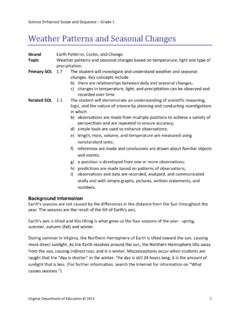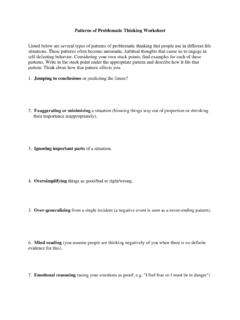Transcription of Introduction to Design Patterns in C# - Lab Software
1 Copyright , 2002 by James W Cooper Introduction to Design Patterns in C# Copyright 2002 by James W. Cooper IBM T J Watson Research Center February 1, 2002 Copyright , 2002 by James W Cooper 21. What are Design Patterns ?..21 Defining Design The Learning Studying Design Notes on Object-Oriented C# Design How This Book Is 2. Syntax of the C# Data Converting Between Numbers and Declaring Multiple Numeric Character Declaring Variables as You Use Multiple Equals Signs for A Simple C# Compiling & Running This Arithmetic Increment and Decrement Combining Arithmetic and Assignment Making Decisions in C#..38 Comparison Copyright , 2002 by James W Cooper 3 Combining The Most Common The switch C# The Ornery Ternary Looping Statements in C#..42 The while The do-while The for Declaring Variables as Needed in For Commas in for Loop How C# Differs From 3.
2 Writing Windows C# Objects in C#..47 Managed Languages and Garbage Classes and Namespaces in C#..48 Building a C# The Simplest Window Program in C#..50 Windows Copyright , 2002 by James W Cooper Radio Listboxes and Combo The Items Other Windows The Windows Controls Programs on the 4. Using Classes and Objects in C#..62 What Do We Use Classes For?..62 A Simple Temperature Conversion Building a Temperature Converting to Putting the Decisions into the Temperature Using Classes for Format and Value Handling Unreasonable A String Tokenizer Classes as Class Classes and Copyright , 2002 by James W Cooper 5 Programming Style in C#..79 Programs on the 5. Drawing and Graphics in C#..82 Using Creating a Square From a Public, Private and Virtual and Override Overriding Methods in Derived Replacing Methods Using Overriding Windows Abstract Comparing Interfaces and Abstract Programs on the 6.
3 UML Copyright , 2002 by James W Cooper WithClass UML C# Project 7. Arrays, Files and Exceptions in C#..107 Collection Multiple Throwing File The File Reading Text Writing a Text Exceptions in File Testing for End of A csFile 8. The Simple Factory How a Simple Factory Sample Copyright , 2002 by James W Cooper 7 The Two Derived Building the Simple Using the Factory Patterns in Math Programs on the Thought 9. The Factory The Swimmer The Events Straight Circle Our Seeding Other When to Use a Factory Thought Programs on the 10. The Abstract Factory A GardenMaker The Handling the RadioButton and Button Adding More Consequences of Abstract Thought Copyright , 2002 by James W Cooper 8 Programs on the 11. The Singleton Creating Singleton Using a Static Exceptions and Throwing the Creating an Instance of the Providing a Global Point of Access to a Other Consequences of the Singleton Programs on Your 12.
4 The Builder An Investment The Stock The CheckChoice The ListboxChoice Using the Items Collection in the ListBox Plotting the The Final Consequences of the Builder Thought Programs on the 13. The Prototype Cloning in C#..163 Using the Copyright , 2002 by James W Cooper 9 Cloning the Using the Prototype Dissimilar Classes with the Same Prototype Consequences of the Prototype Thought Programs on the Summary of Creational 14. The Adapter Moving Data Between Making an Using the Detecting Row Using a The Class Two-Way Object Versus Class Adapters in C#..190 Pluggable Thought Programs on the 15. The Bridge The VisList The Class Copyright , 2002 by James W Cooper 10 Extending the Windows Forms as Consequences of the Bridge Thought Programs on the 16. The Composite An Implementation of a Computing The Employee The Boss Building the Employee Doubly Linked Consequences of the Composite A Simple Composites in.
5 Other Implementation Thought Programs on the 17. The Decorator Decorating a Handling events in a Layout Copyright , 2002 by James W Cooper 11 Control Size and Multiple Nonvisual Decorators, Adapters, and Consequences of the Decorator Thought Programs on the 18. The Fa ade What Is a Database?..228 Getting Data Out of Kinds of Database Using Connecting to a Reading Data from a Database dtable = [0];..235 Executing a Deleting the Contents of a Adding Rows to Database Tables Using Building the Fa ade Building the Price Making the Fa Copyright , 2002 by James W Cooper 12 The DBTable Creating Classes for Each Building the Price Loading the Database The Final What Constitutes the Fa ade?..252 Consequences of the Fa Thought Programs on the 19. The Flyweight Example The Class Selecting a Handling the Mouse and Paint Flyweight Uses in C#.
6 264 Sharable Copy-on-Write Thought Programs on the 20. The Proxy Sample Proxies in C#..270 Copyright , 2002 by James W Cooper 13 Comparison with Related Thought Programs on the 21. Chain of Sample The List Programming a Help Receiving the Help A Chain or a Tree?..287 Kinds of Examples in C#..289 Consequences of the Chain of Thought Programs on the 22. The Command Command Building Command Consequences of the Command The CommandHolder Providing Copyright , 2002 by James W Cooper 14 Thought Programs on the 23. The Interpreter A Simple Report Interpreting the Objects Used in Reducing the Parsed Implementing the Interpreter The Syntax Consequences of the Interpreter Thought Programs on the 24. The Iterator Sample Iterator Fetching an Filtered The Filtered Keeping Track of the Consequences of the Iterator Programs on the Copyright , 2002 by James W Cooper 15 25.
7 The Mediator An Example Interactions Between Sample Initialization of the Mediators and Command Consequences of the Mediator Single Interface Implementation Programs on the 26. The Memento Sample A Cautionary Command Objects in the User Handling Mouse and Paint Consequences of the Thought Programs on the 27. The Observer Watching Colors The Message to the Copyright , 2002 by James W Cooper 16 Consequences of the Observer Programs on the 28. The State Sample Switching Between How the Mediator Interacts with the State The Handling the Fill Handling the Undo The VisRectangle and VisCircle Mediators and the God Consequences of the State State Thought Programs on the 29. The Strategy Sample The The Program The Line and Bar Graph Drawing Plots in C#.
8 394 Making Bar Copyright , 2002 by James W Cooper 17 Making Line Consequences of the Strategy Programs on the 30. The Template Method Kinds of Methods in a Template Sample Drawing a Standard Drawing an Isosceles The Triangle Drawing Templates and Summary and Programs on the 31. The Visitor When to Use the Visitor Sample Visiting the Visiting Several Bosses Are Employees, Catch-All Operations with Double Why Are We Doing This?..419 Copyright , 2002 by James W Cooper 18 Traversing a Series of Consequences of the Visitor Thought Programs on the 32. Copyright , 2002 by James W Cooper 19 Preface This is a practical book that tells you how to write C# programs using some of the most common Design Patterns . It also serves as a quick Introduction to programming in the new C# language.
9 The pattern discussions are structured as a series of short chapters, each describing a Design pattern and giving one or more complete working, visual example programs that use that pattern. Each chapter also includes UML diagrams illustrating how the classes interact. This book is not a "companion" book to the well-known Design Patterns text. by the "Gang of Four." Instead, it is a tutorial for people who want to learn what Design Patterns are about and how to use them in their work. You do not have to have read Design Patterns to read this book, but when you are done here you may well want to read or reread it to gain additional insights. In this book, you will learn that Design Patterns are frequently used ways of organizing objects in your programs to make them easier to write and modify. You ll also see that by familiarizing yourself with them, you ve gained some valuable vocabulary for discussing how your programs are constructed.
10 People come to appreciate Design Patterns in different ways from the highly theoretical to the intensely practical and when they finally see the great power of these Patterns , an Aha! moment occurs. Usually this moment means that you suddenly have an internal picture of how that pattern can help you in your work. In this book, we try to help you form that conceptual idea, or gestalt, by describing the pattern in as many ways as possible. The book is organized into six main sections: an introductory description, an Introduction to C#, and descriptions of Patterns , grouped as creational, structural, and behavioral. Copyright , 2002 by James W Cooper 20 For each pattern, we start with a brief verbal description and then build simple example programs. Each of these examples is a visual program that you can run and examine to make the pattern as concrete a concept as possible.








